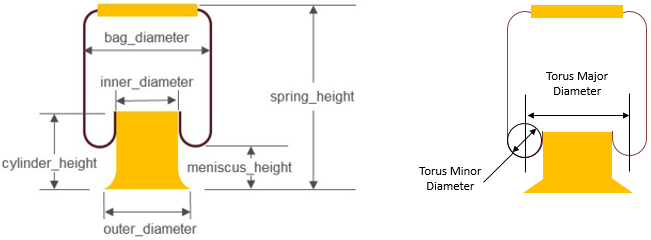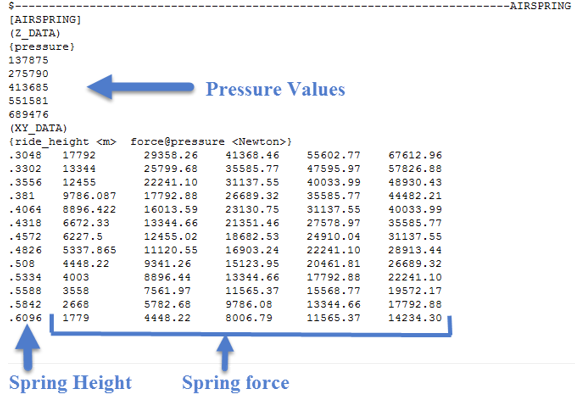TeimOrbit File for AirSpring |

|

|

|

|
|
TeimOrbit File for AirSpring |

|

|

|

|
An example TeimOrbit file for Airspring is shown below. The different blocks available in the TeimOrbit file are described in the following headings.
The HEADER block gives the file type, version, and format information.

The UNITS block specifies the length, mass, force, time and angle units employed in the file. Units are not case sensitive – meter, Meter, METER, or Meter are all interpreted same. The UNITS block is required for all types of the data files to be read by the builder.

The PARAMETERS block lists the values of inner diameter, bag diameter, spring height, cylinder height, outer diameter, and meniscus height of the rolling lobe spring in the AirSpring file. Rolling lobe springs are primary suspension springs in Trucks, Buses, Passenger Cars, Rail Vehicles, and other vehicles. To calculate the Torus Minor Radius and Torus Major Radius the following formula is used:
| • | Torus Major Radius = Inner Diameter/2+(Bag Diameter-Inner Diameter)/4 |
| • | Torus Minor Radius = (Bag Diameter-Inner Diameter)/4 |


The AIRSPRING block gives the spring force verses deflection for different static pressures. The AIRSPRING block has two sub-blocks:
| 1. | Z_DATA |
| 2. | XY_DATA |
The Z_DATA sub-block gives the nominal internal spring pressure for each force verses deflection curve. The XY_DATA sub-block contains multiple force verses deflection curves.
The first column of the XY_DATA sub-block (in the example below) is spring height and each subsequent column is the spring force for one pressure defined in the Z_DATA sub-block. Therefore the forces in the second column correspond to the first internal pressure (137875 Newton/Meter2), and the forces in the third column correspond to the second internal pressure (275790 Newton/Meter2), and so on.
The spring height provided in the first column should cover the full range of the air spring heights. During a simulation if the spring height outside the range of height provided, MotionSolve linearly extrapolates the spring force with spring height.
Also, based on the trim load and trim height provided in the user interface, the Newton Raphson method is used to evaluate the equilibrium pressure from the spline data and subsequently, the force-displacement curve corresponding to the equilibrium pressure calculated is used for the simulation.
